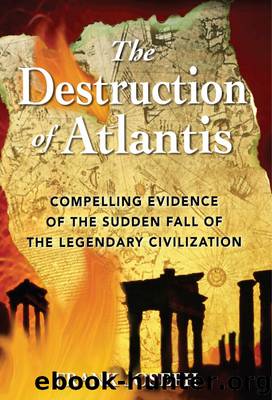The Destruction of Atlantis by Frank Joseph

Author:Frank Joseph [Frank Joseph]
Language: eng
Format: epub
Publisher: Inner Traditions/Bear & Company
Published: 2011-04-18T00:00:00+00:00
A typical variant of the Atlantean flood story is known to the Cherokee, Iroquoian people originally from the Great Lakes who migrated to eastern Tennessee and the western Carolinas. They preserved the story of Unadatsug, âthe Group,â stars known in the West as the Pleiades. It was from this constellation that a star with âa fiery tailâ fell to Earth. At the impact site, a gigantic palm tree suddenly arose and the extinguished star changed into an old man who warned against a coming deluge. The palm tree is most likely a poetic description of the mushroom cloud that resulted from the meteorite impact.50
The Cherokee myth is remarkably similar to both the Greek story of Electra, the missing Pleiade whose fall presaged a flood, and the Hebrew deluge account, wherein Yahweh cast down a star from the Pleiades to initiate a catastrophe. From the Arctic Circle to Cape Horn, the Pleiades constellation was identified with a worldwide flood from which culture bearers survived to found new societies. The Seven Sisters were Atlantises, daughters of Atlas, and their widespread association with an ancestral deluge not only reinforces the reality of Platoâs sunken civilization, but demonstrates that it played a seminal role in pre-Columbian American cultures.
That the Pleiades were identified with Atlas just as much in North America as they were in Europe is established by the Hopi Indian myth of Machito. Like Atlas, he âraised the firmament on his shoulders,â then summoned seven maidens, who wove the moon into existence. Thereafter, they ascended into the heavens to form their constellation. âMachito appointed times and seasons and ways of the heavenly bodies. And the gods of the firmament have obeyed the injunctions of Machito from the day of their creation to the present.â To the Greeks, Atlas was the inventor of astronomy and astrology. And both the Hopi and Greeks regarded the Pleiades as sisters.51
The Hopi deluge account is remarkably similar to the Norse version in the Eddas: âMountains plunged into the sea with a great splash, seas and lakes sloshed over the land.â Immediately afterward, the whole world âfroze into solid ice.â52 The Hopi believe that the flood destroyed a Third Age of humanity remembered as the Kurskursa, a term that also refers to the copper- or bronze-tinged red color that comes with the sunrise. The Kurskursa was characterized as an extended period when great cities were built and men made far-flung war on each other until a catastrophe annihilated most of them and obliterated their capitals. Again, a strong echo of Platoâs Kritias in Native American tradition.
Aztec priests used the rising of the Pleiades to mark the beginning of the new year; their appearance was identified with the Fourth Age, that which immediately precedes our own, the era of a world flood. Each fifty-two-week calendar began precisely when the Pleiades crossed the Fifth Cardinal Point (the zenith of heaven) at midnight in mid-November. The priests then repaired to the Hill of the Star, a hilltop on a peninsula jutting out into the very middle of a lake that surrounded the Aztec capital, Texcoco.
Download
This site does not store any files on its server. We only index and link to content provided by other sites. Please contact the content providers to delete copyright contents if any and email us, we'll remove relevant links or contents immediately.
| Ancient & Controversial Knowledge | Ghosts & Hauntings |
| Hermetism & Rosicrucianism | Magic Studies |
| Occultism | Parapsychology |
| Supernatural | UFOs |
| Unexplained Mysteries |
Animal Frequency by Melissa Alvarez(4399)
Sigil Witchery by Laura Tempest Zakroff(4181)
Real Magic by Dean Radin PhD(4075)
Fingerprints of the Gods by Graham Hancock(3943)
Aleister Crowley: The Biography by Tobias Churton(3589)
Journeys Out of the Body by Robert Monroe(3572)
The Rosicrucians by Christopher McIntosh(3467)
Alchemy and Alchemists by C. J. S. Thompson(3452)
Mysteries by Colin Wilson(3398)
Hitler's Monsters by Eric Kurlander(3269)
The Hatha Yoga Pradipika (Translated) by Svatmarama(3234)
John Dee and the Empire of Angels by Jason Louv(3132)
Wicca: a guide for the solitary practitioner by Scott Cunningham(3127)
Infinite Energy Technologies by Finley Eversole(2939)
Book of Life by Deborah Harkness(2869)
Dark Star Rising by Gary Lachman(2830)
The Book of Lies by Aleister Crowley(2802)
Aliens by Jim Al-Khalili(2788)
To Light a Sacred Flame by Silver RavenWolf(2769)
